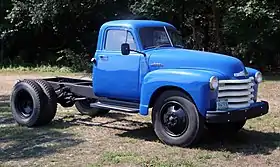Chevrolet Advance Design
The Advance-Design is a light and medium duty truck series by Chevrolet, their first major redesign after WWII. It was bigger, bolder, and featured a horizontal 5 bar grille which is recognized to many as one of the most iconic designs in all of automotive history. Its GMC counterpart was the GMC New Design. It was billed as a larger, stronger, and sleeker design in comparison to the earlier AK Series. First available on Saturday, June 28, 1947, these trucks were sold with various minor changes over the years[3] until March 25, 1955, when the Task Force Series trucks replaced the Advance-Design model.
The same basic design family was used for all of its trucks including the Suburban, panel trucks, canopy express, and cab overs. The cab overs used the same basic cab configuration and similar grille but used a shorter and taller hood and different fenders. The unique cab over fenders and hood required a custom cowl area which makes the cab over engine cabs and normal truck cabs incompatible with one another while all truck cabs of all weights interchange. The primary exterior change on the 1954 model year of the medium light duty trucks was a new front grille resembles the iconic Dodge intersecting cross bar grille and a updated bed design which remained unchanged from the previous years from 1948 to 1953.
From 1947 until 1955, Chevrolet trucks were number one in sales in the United States, with rebranded versions sold at GMC locations.[4]
While General Motors used this front end sheet metal, and to a slightly lesser extent the cab, on all of its trucks except for the cab overs, there are three main sizes of this truck: the half-, three-quarter-, and full-ton capacities in short and long wheelbase.
Differences
1947 - Gasoline tank filler neck on passenger side of bed. No vent windows in doors. Hood side emblems read "Chevrolet" with "Thriftmaster" or "Loadmaster" underneath. Serial numbers: EP 1⁄2 ton, ER 3⁄4 ton, & ES 1 ton.[5] Radios were first available in Chevrolet trucks as an "in dash" option on the "Advance-Design" body style.[6]
1948 - Manual transmission shifter now mounted on column instead of floor. Serial numbers codes: FP 1⁄2 ton, FR 3⁄4 ton, & FS 1 ton.
Early 1949 - Gasoline tank now mounted upright behind seat in cab; filler neck aft of passenger door handle. New serial number codes: GP 1⁄2 ton, GR 3⁄4 ton, & GS 1 ton.
Late 1949 - Hood side emblems no longer read "Thriftmaster" or "Loadmaster", but are now numbers that designate cargo capacity: 3100 on 1⁄2 ton, 3600 on 3⁄4 ton, 3800 on 1 ton. Serial number codes remain the same as on early 1949.
1950 - Telescopic shock absorbers replace lever-action type. Last year for driver's side cowl vent, its handle is now flat steel, not maroon knob as in previous years. New serial number codes: HP 1⁄2 ton, HR 3⁄4 ton, & HS 1 ton.
1951 - Doors now have vent windows. Mid-year change from 9-board bed to 8 boards per bed. Last year for 80 mph speedometer, chrome window handle knobs, and chrome wiper knob. New serial number codes: JP 1⁄2 ton, JR 3⁄4 ton, & JS 1 ton.
1952 - Outer door handles are now push button type as opposed to the previous turn down style. Speedometer now reads 90 mph instead of 80 and dashboard trim is color-matched instead of chrome. Mid-year, Chevrolet no longer uses the 3100-6400 designation on the hood and changes to maroon window and wiper knobs. New serial number codes: KP 1⁄2 ton, KR 3⁄4 ton, & KS 1 ton.
1953 - Last year for the 216 in3 inline-six. Hood side emblems now only read 3100, 3600, 3800, 4400, or 6400 in large print. Door post ID plate now blue with silver letters (previous models used black with silver letters). Last year to use wooden blocks as bed supports. New serial number codes: H 1⁄2 ton, J 3⁄4 ton, & L 1 ton.
1954 - Only year for significant design changes. Windshield now curved one-piece glass without center vertical dividing strip. Revised steering wheel. Revised dashboard. Cargo bed rails, previously angled, now horizontal. Tail lights round instead of rectangular. Grille changed from five horizontal slats to crossbar design commonly referred to as a "bull nose" grille, similar to modern Dodge truck grilles. New engines are now 235-cubic inch straight-6 and 261-cubic inch straight-6. Serial number codes unchanged from 1953. Hydramatic automatic transmission is available for the first time as a paid for option.
1955 First Series - Similar to the 1954 model year, except redesigned hood-side emblems and modern open driveshaft in place of enclosed torque tube. Serial number codes unchanged from 1953 and 1954.
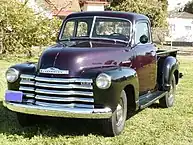 1948 Chevrolet Thriftmaster pickup truck
1948 Chevrolet Thriftmaster pickup truck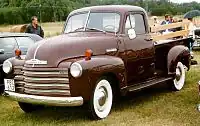 1951 Chevrolet Advance Design
1951 Chevrolet Advance Design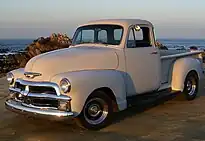 1954 Chevrolet 3100
1954 Chevrolet 3100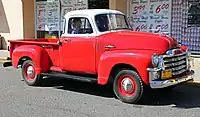 1954 GMC 100
1954 GMC 100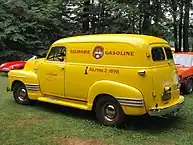 1951 Chevrolet 3100 panel van
1951 Chevrolet 3100 panel van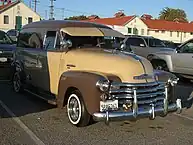 Chevrolet 3100 panel van with two-tone paint
Chevrolet 3100 panel van with two-tone paint.jpg.webp) 1949 Chevrolet Suburban
1949 Chevrolet Suburban
GMC HC-Series
| GM HC-Series | |
|---|---|
.jpg.webp) GM HC-Series | |
| Overview | |
| Model years | 1949–1958 |
| Chronology | |
| Successor | GMC F/D "Crackerbox" (HF-Series models only) |
The GMC HC-Series is a medium/heavy-duty version of the Chevrolet Advance Design truck. The HC was mostly used as a semi-truck although smaller platform truck versions were also made and were available. These trucks had a narrower hood and fenders compared to their lighter counterparts.
Air brakes were a feature included in this truck. The HC could carry 27,000 lb (12,000 kg) GVW or 55,000 lb (25,000 kg) GCW depending on the version of the truck.[7] A cab-over version based on the HC-Series was also produced, under the HF-Series name, although it was popularly nicknamed the Cannonball,[8] after a TV series featuring it. It continued until 1958, when it was replaced by the GMC F/D "Crackerbox".
Styling legacy
With the truck proving to be very popular in the United States, the same "Advance-Design" styling was used on other trucks made overseas by General Motors' divisions such as Opel and Vauxhall. Both the redesigned 1952 Opel Blitz and 1953 Bedford A-Type were stylistically heavily based on the Advance Design truck.[9]
During the retro-craze of the 2000s, the style of the Advance Design was used for the Chevrolet SSR roadster pickup and later for the Chevrolet HHR crossover SUV, the latter of which lasted in production until 2012.
The styling legacy resurfaced in 2022 with the Chevrolet Silverado High Country trim, having two headlights instead of the usual four. A bolder chrome four bar grille with a brushed aluminum bar running through the top of the headlights gives a retro-style look similar to the original-five bar grille from the Advanced Design trucks from 1947 to 1953.
References
- "Directory Index: GM Trucks and Vans/1948 Trucks and Vans/1948 Chevrolet Trucks Brochure". Oldcarbrochures.com. Retrieved November 20, 2011.
- Gunnell, John A. (1993). Standard Catalog of American Light-Duty Trucks. Krause Publications. ISBN 0-87341-238-9.
- "Find the Chevy pickup part for your truck and have it shipped within 3 days at ClassicParts.com". www.classicparts.com. Retrieved April 1, 2023.
- Bunn, Don. "Segment Five: 1947-1954 Advanced Design Pickups". Pickuptruck.com. Archived from the original on October 18, 2007.
- "What Year is My Truck?". Classicparts.com. Retrieved February 3, 2008.
- "Introduction to A-D factoids". 2007. Retrieved May 18, 2015.
- GM, Diesel Trucks. "Gasoline". autopaper.com. Autopaper. Retrieved December 5, 2020.
- "What was the GMC Cannonball?". Retrieved September 11, 2021.
- "Bedford TA & TD Series Information". Retrieved September 12, 2021.
